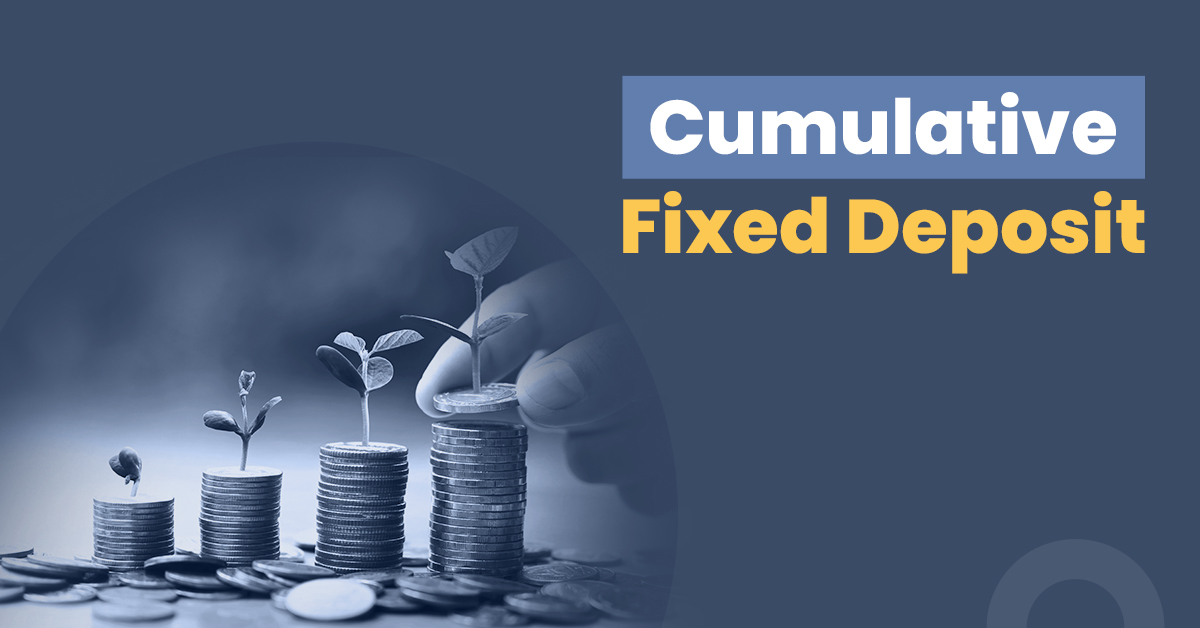Cumulative FD: Interest Rates 2023-24, Meaning, Definition


Fixed deposits (FD) are highly popular investment instruments. The fixed and predictable returns, the flexibility in choosing the duration, and the feasible investment amount make FDs a much sought-after savings scheme. Moreover, banks, deposit-taking non-banking financial companies (NBFCs), and post offices offer a range of fixed deposit schemes to suit the varied needs of different investors. If you are a risk-averse investor, you could consider investing in fixed deposit schemes.
Depending on the payout of the interest amount, fixed deposits are categorised into cumulative and non-cumulative FDs. These schemes differ in interest payments even though the interest rates may be the same. Based on your financial goals, you can choose to invest in either or both of these schemes. Here is a complete low-down on what a cumulative FD means.
What is Cumulative FD?
A Cumulative FD is a scheme wherein the interest on your investment accumulates during the deposit tenure. The interest is compounded annually or quarterly, depending on your preferred scheme. It means that the earned interest is reinvested in the FD account—interest gets added to the principal amount—and the subsequent interest is then calculated on the aggregate amount. The accrued interest is paid along with the principal amount on maturity. Cumulative FDs are best suited for investors who do not need a regular income and want to create a substantial deposit over a longer term.
Suppose you open a cumulative fixed deposit account with a bank and deposit Rs. 1 lakh for six years at an interest rate of 6.5% per annum compounded annually. In this case, here’s how the interest would accumulate over the deposit period:
| Year | Investment Value | Amount of Interest | Amount at the year-end |
| 1 | Rs. 1,00,000 | Rs. 6,500 | Rs. 1,06,500 |
| 2 | Rs. 1,06,500 | Rs. 6,922 | Rs. 1,13,422 |
| 3 | Rs. 1,13,422 | Rs. 7,372 | Rs. 1,20,795 |
| 4 | Rs. 1,20,795 | Rs. 7,851 | Rs. 1,28,646 |
| 5 | Rs. 1,28,646 | Rs. 8,362 | Rs. 1,37,008 |
| 6 | Rs. 1,37,008 | Rs. 8,906 | Rs. 1,45,914 |
The calculation above shows how interest earned on the FD is added up each year to the previous principal amount. Every year, interest is calculated on both the principal and the accumulated interest. The total interest that you earn on the FD is Rs. 45,913. It will be credited to your account in a lump sum at the end of 6 years, along with the principal amount.
Also Read: FD Interest Rates Comparison
Who Should Invest in a Cumulative FD?
Here are the typical groups of people that would benefit the most from investing in a Cumulative FD:
Long-Term Investing: Cumulative FDs may appeal to those searching for long-term investment solutions to build wealth over time because they take advantage of compound interest.
Investors who avoid risk: Cumulative FDs, which give a fixed interest rate and are typically seen as safe, may be preferred by people who would rather avoid riskier investments like stocks or mutual funds.
Retirement Planners: A cumulative FD may be chosen by those who are saving for retirement and want to grow a portion of their funds without regular income requirements.
Savings with a Purpose:
Specified Goals: Cumulative FDs are a good option for people who want to increase their savings while working towards a specific financial goal (such as purchasing a home or paying for college).
Tax Advisors: Cumulative options are good for people who want to minimise their tax by investing in tax-saving FDs, especially if they don’t need regular interest income.
Young Traders:
Young Investors: A cumulative FD is a good place for new investors to start because it’s simple to comprehend and administer.
Irregular Income Needs: Cumulative FDs may be preferred by people who do not need recurring interest payments to maximise compounding.
Cumulative FD Interest Rates 2024
The interest rate on cumulative fixed deposits depends on the financial institution. Here are the interest rates on cumulative FDs offered by a few banks/NBFCs for deposits below Rs. 2 crores:
Indian Banks | Regular Interest Rates | Interest Rates for Senior Citizens |
| Axis Bank | 3.50% to 7.10% | 3.50% to 7.85% |
| Bajaj Finance | 7.40% to 8.35% | 7.65% to 8.60% |
| ICICI Bank | 3.00% to 6.90% | 3.50% to 7.50% |
| HDFC Bank | 3.00% to 7.25% | 3.50% to 7.75% |
| SBI Bank | 3.00% to 7.10% | 3.50% to 7.60% |
Also Read: Experience financial growth with unmatched Bajaj Finance FD Rates
Differences Between Cumulative FD and Non-cumulative FD
As mentioned earlier, fixed deposits are classified as cumulative or non-cumulative. Here’s how they differ:
| Points of difference | Cumulative fixed deposit scheme | Non-cumulative fixed deposit scheme |
| Meaning | Under this scheme, the interest is compounded and accumulated throughout the term of the FD, and paid along with the principal at the maturity of the FD. | Under this scheme,interest is paid periodically to investors on a monthly, quarterly, half-yearly or yearly basis. Only the principal amount is paid on maturity. |
| Flow of income | There is no regular income flow, the interest accrued along with the principal is paid at maturity. | Regular flow of income. |
| Who is it suitable for? | Cumulative fixed deposits are suitable for individuals who are not dependent on a regular interest income and want to receive a lump sum fund at the end of their tenure to meet a specific goal. | Non-cumulative fixed deposits are suitable for investors looking for a regular source of income. For example, pensioners or retirees needing a regular flow of income can opt for these. |
| Returns earned | The effective returns on cumulative fixed deposit schemes are higher in comparison to non-cumulative fixed deposits. The reason is simple: under these schemes, you earn interest on the interest you have already earned. Hence, the overall interest earned during the term is higher. | The returns of non-cumulative fixed deposit schemes are lower in comparison to cumulative deposits. This is because there is no compounding; you earn interest on the principal amount only, not on the previously earned interest values. |
Furthermore, many financial institutions have different interest rates for cumulative and non-cumulative fixed deposit schemes. It is best to check the interest rates before you invest.
Also Read: EPF vs PPF: Which one is a better investment option?
Final Thoughts
A Cumulative FD is also known as a money multiplier scheme, as the interest gets compounded until maturity. This type of FD is ideal for people who are not looking to earn regular interest or have a steady income from investment. If you want to save for a particular goal and earn reasonable returns on your investment, you can consider opting for a cumulative fixed deposit.
When opting for a fixed deposit scheme, remember that cumulative FD will create a lump sum corpus on maturity, while non-cumulative FD will create a regular and guaranteed stream of income throughout the deposit tenure. It ultimately boils down to your requirements and financial goals.
FAQs
How to choose the best cumulative fixed deposit scheme?
Many financial institutions offer cumulative fixed deposit schemes. To choose the best, compare the interest rates offered. The best scheme would be the one that offers the highest interest rate so that you can earn the maximum possible returns. Also, compare the minimum investment amount, frequency of compounding and the available deposit terms. Ensure that the deposit meets your financial needs.
What is the tax benefit of a cumulative fixed deposit scheme?
You can get tax deductions through the investment you make in a 5-year tax saving FD (both cumulative and non-cumulative). You can claim a deduction of up to Rs.1.5 lakh under Section 80C of the Income Tax Act, 1961.
What are the minimum and maximum amounts of investment required in a cumulative FD?
The minimum investment amount depends on the financial institution. Different institutions have different requirements. Some financial institutions might require a minimum deposit of Rs.1,000; others may ask for a minimum deposit of over Rs. 5,000. As far as the maximum amount is concerned, there is usually no limit.
What are the minimum and maximum tenures of fixed deposits?
The minimum and maximum tenure depend on the financial institution. However, in the case of banks, the minimum and maximum tenures usually range between seven days to 10 years.
Is TDS payable on a cumulative FD scheme?
Yes, TDS is payable on your cumulative FD interest income if it exceeds Rs.40,000 in a financial year. For senior citizens, the TDS limit is Rs.50,000. Interest income below these limits does not attract TDS. However, if you have not intimated your Permanent Account Number (PAN) details to the bank, then the TDS rate is 20%. It should be taken into consideration that TDS deducted on FD is at the time of credit of interest and not at maturity.
If your overall income is below the limit of Rs. 2.5 lakh, you can submit Form 15G/H to the financial institution to avoid a TDS deduction on the FD interest income.
For fixed deposits, how is cumulative interest credited?
In cumulative FDs, the interest is compounded and added back to the principal amount, and the total amount (principal + interest) is credited at maturity.
Which is better, cumulative FD or traditional FD?
Choosing between cumulative and traditional FDs depends on individual financial needs; cumulative FDs are better for wealth accumulation, while traditional FDs provide regular income.
What are the benefits of cumulative deposits?
Cumulative deposits offer the benefit of compound interest, leading to higher returns over time, especially for investors who do not require periodic interest payouts.



